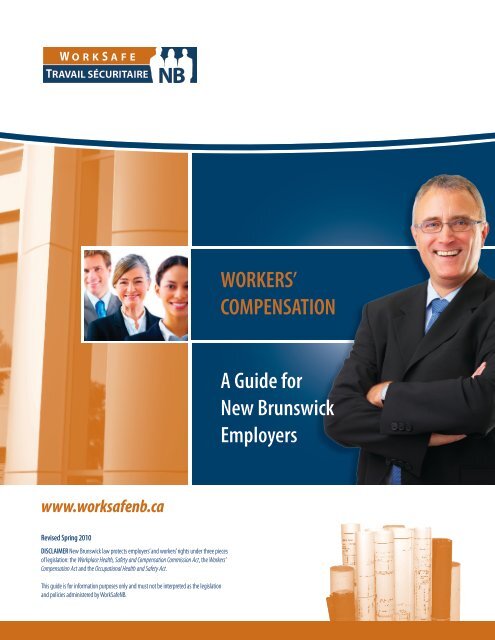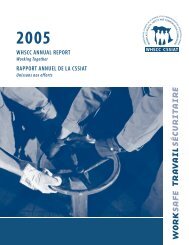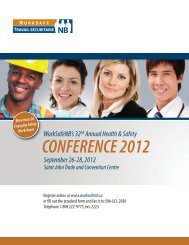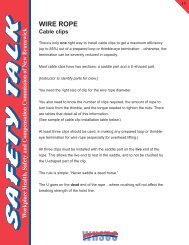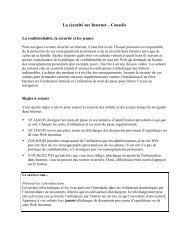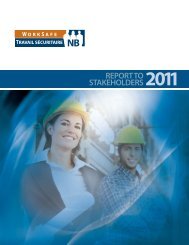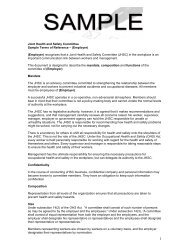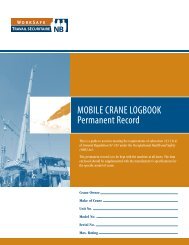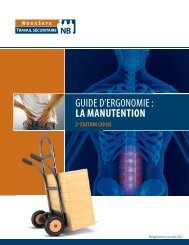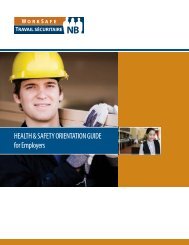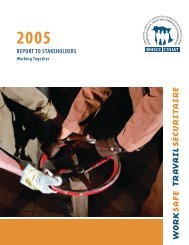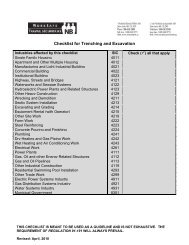COMPENSATION A Guide for New Brunswick ... - WorkSafeNB
COMPENSATION A Guide for New Brunswick ... - WorkSafeNB
COMPENSATION A Guide for New Brunswick ... - WorkSafeNB
You also want an ePaper? Increase the reach of your titles
YUMPU automatically turns print PDFs into web optimized ePapers that Google loves.
Table of Contents<strong>WorkSafeNB</strong>_____________________________________________________ page 1• WHAT IS <strong>WorkSafeNB</strong>• THE OCCUPATIONAL HEALTH AND SAFETY ACT• THE WORKERS’ <strong>COMPENSATION</strong> ACT• THE WORKPLACE HEALTH, SAFETY AND <strong>COMPENSATION</strong> COMMISSION ACT• GUIDING PRINCIPLES OF WORKERS’ <strong>COMPENSATION</strong>• roLES AND RESPONSIBILITIESCoverage and_reporting _ __________________________________________ page 5• COVERAGE AND REPORTING OF ACCIDENTS• DEFINITION OF AN “EMPLOYER”• DEFINITION OF A “WORKER”<strong>WorkSafeNB</strong> Coverage _ _______________________________________ page 7• CONTRACTORS FROM NEW BRUNSWICK• CONTRACTORS FROM OUTSIDE NEW BRUNSWICK• COST RECOVERY FROM UNREGISTERED CONTRACTORSASSESSED PREMIUMFACtorS AFFECTING Coverage___________________________________ page 10• WORKERS’ <strong>COMPENSATION</strong> COVERAGE• TEMPORARY COVERAGE FROM THE RECEIVING JURISDICTION• EXTENDED <strong>WorkSafeNB</strong> COVERAGE• IMMUNITY ISSUESi
REGISTERING _ ___________________________________________________ page 12• NeWeMPLoyerS• GroWINGBUSINeSSes• CoNTrACTorSfroMAnoTHer JurISDICTIon• fACTorSAffeCTINGYour ACCoUNT• ClearANCe CerTIfICATesPremium Calculation _ ___________________________________________ page 15IMPORTANT DATES• CALCULATINGYour ASSeSSMeNTrATeSPECIAL CLASSIFICatioN CONSIDERATIONS• CAPITAL CONSTRUCTION• CLASSIFICATIONofeMPLOYerAffILIATES• OPerATIONS IN MoreTHANoNeJURISDICTION• MULTIPLeBUSINESS ACTIVITY• SUPPorTIVeBUSINESS ACTIVITY• INTerMINGLED BUSINESS ACTIVITY• OUT-of-ProVINCeADMINISTRATION• MANAGEMENT COMPANYEXPERIENCE RATING• DETERMINING AND REPORTING ASSESSABLE EARNINGS• WHAT ARE ASSESSABLE EARNINGS?• WHAT ARE NON-ASSESSABLE EARNINGS?FORM 100• PAYroLL AUDITS• PREMIUM CALCULATION AND PAYMENTOPTION AoPTION Bii
JoB_Site HealtH_and Safety ________________________________________ page 25• HEALTH AND SAFETY AT YOUR JOB SITE(S)• <strong>WorkSafeNB</strong> HEALTH AND SAFETY RESOURCESIn Case of aN_aCCident ___________________________________________ page 28• DEFINITION OF AN ACCIDENT• EMPLOYERS MUST REPORT THE INJURY TO <strong>WorkSafeNB</strong>YOU MUST REPORT WORK-RELATED ACCIDENTS OR DISEASES• POST-ACCIDENT RESPONSIBILITIES FOR EVERYONE INVOLVEDCompeNSatioN_and_rehabilitation ___________________________________ page 33• BENEFITS INJURED WORKERS CAN RECEIVESUBSECTION 42.1(2)• MODIFIED EMPLOYMENT• ALTERNATE EMPLOYMENT• ACCESS TO INFORMATIONAppeals _______________________________________________________ page 36• QUESTIONING A DECISION• HoWTo SUBMITANAPPeAL• AfterANAPPeALSHearINGEmployer_advocateS _ ____________________________________________ page 39• RESPONSIBILITIES OF EMPLOYER ADVOCATES• CONTACT INFORMATION• EMERGENCIESHOW_to_CONtaCt_<strong>WorkSafeNB</strong> ________________________________________ page 40• EMERGENCIESiii
Our VISIONHealthy and safe workplaces in<strong>New</strong> <strong>Brunswick</strong>MiSSion<strong>WorkSafeNB</strong> will promote a safe and healthy work environment to theworkers and employers of <strong>New</strong> <strong>Brunswick</strong>, and efficiently provide qualityservices, just adjudication and fair administration of the legislation.MandatePromote the creation of a workplace safety culture in which all employeesand employers view all occupational diseases and accidents as beingpreventable.Provide timely compensation benefits, medical aid, rehabilitation and safereturn-to-work services to injured workers.Provide sustainable insurance and insurance-related services to the employercommunity.Represent stakeholders and provide recommendations and advice togovernment with respect to legislation and publish such reports, studies andrecommendations.ValuesWe dedicate ourselves to the provision of prompt, effective, efficient andcaring services to each of our clients.We believe that a team approach ensures that all members of <strong>WorkSafeNB</strong>are working towards a shared vision, mission, values and goals.We are committed to providing competent and energetic leadership that isfocused on a clear direction <strong>for</strong> <strong>WorkSafeNB</strong>.We ensure that our decisions are made with integrity, credibility, andaccountability.We ensure that our communications are based on trust, mutual respect,openness, and clear and reliable in<strong>for</strong>mation.We manage our human, material and financial resources effectively inresponding to our mandate and established priorities.iv
<strong>WorkSafeNB</strong>What iS_<strong>WorkSafeNB</strong>?<strong>WorkSafeNB</strong> is dedicated to promoting a safe and healthywork environment and providing services to employersand workers in <strong>New</strong> <strong>Brunswick</strong>.<strong>WorkSafeNB</strong> is an employer-funded Crown corporation,and not a provincial government department.<strong>WorkSafeNB</strong> reports to the <strong>New</strong> <strong>Brunswick</strong> Legislaturethrough the Minister of Post-Secondary Education,Training and Labour, and provides cost-effective disabilityand liability insurance to approximately 13,500 employersand approximately 350,000 workers in <strong>New</strong> <strong>Brunswick</strong>.<strong>WorkSafeNB</strong> administers three acts:(1) The Occupational Health and Safety (OHS)Act and regulations(2) The Workers’ Compensation (WC) Act andregulations(3) The Workplace Health, Safety andCompensation Commission (WHSCC) ActThis guide primarily addresses the legislativerequirements of the WC Act.The Workers’ cOmpensation (WC) ActLike other pieces of workers’ compensation legislationin Canada, the WC Act of <strong>New</strong> <strong>Brunswick</strong> is foundedon the Meredith Principles, which <strong>for</strong>med the basis ofa historic agreement between labour and business.According to the Meredith Principles, employers agreedto fund the workers’ compensation program and, inexchange, workers gave up the right to sue employers <strong>for</strong>compensation of work-related injuries. In <strong>New</strong> <strong>Brunswick</strong>,workers’ compensation is administered through a nofaultinsurance system set up under the WC Act.the Workplace Health, Safety andcOmpeNSatiON cOmmiSSiON (WHScc) ActThe WHSCC Act sets out the operational guidelines <strong>for</strong><strong>WorkSafeNB</strong>, empowers it to administer the OHS andWC Acts, and provides <strong>for</strong> an arm’s-length AppealsTribunal.The Occupational Health and Safety(OHS) ActThe OHS Act asserts that every worker is entitled to asafe and healthy workplace. This Act places primaryresponsibility <strong>for</strong> occupational health and safety in thehands of workers and employers, and grants workersthree basic rights:• The right to know about workplace hazards.• The right to participate in solving health and safetyproblems.• The right to refuse dangerous work.For more in<strong>for</strong>mation on your rights and responsibilitiesunder the OHS Act, please call 1 800 222-9775, or visit ourwebsite at: www.worksafenb.ca.1
GUIDING PRINCIPLES OF WORKERS’ <strong>COMPENSATION</strong>No-fault compensation: Workers are eligible to receivebenefits <strong>for</strong> work-related injuries or occupational diseases, nomatter who is at fault.Collective liability: All employers (in covered industries)share responsibility <strong>for</strong> fully funding the cost of workers’compensation insurance.Immunity from suit: Participating employers and theirworkers have universal immunity against lawsuits <strong>for</strong> workrelatedaccidents.Exclusive judicial jurisdiction: The WC Act gives<strong>WorkSafeNB</strong> exclusive legal authority to make all decisionsarising under the Workers’ Compensation Act, subject to therules of natural justice.Fair compensation and premiums: Compensation shouldbe fair, and should account <strong>for</strong> the nature of the injury aswell as the impact on employment earnings. Furthermore,premiums should be fair and competitive, and account <strong>for</strong>the full cost of the system including claims, reserves andadministration.Workers’ compensation in<strong>New</strong> <strong>Brunswick</strong> is guidedby principles <strong>for</strong>mulated bythe <strong>for</strong>mer Chief Justice ofOntario, Sir William Meredith,a century ago.Benefit of doubt to worker: Adjudication decisions favourthe injured worker where all evidence <strong>for</strong> and against isequally balanced.Prevention and disability management: In accordancewith the OHS Act and associated regulations, <strong>WorkSafeNB</strong>provides a comprehensive range of services to both preventinjuries and manage disabilities.Sustainability: The system is operated to ensure its longtermstability, financial security and cost-effectiveness.2
<strong>WorkSafeNB</strong>’s responsibility is to provIDE high qUALITyACCIDENT prevENTION, occupational health and safetyASSISTANCE, cost-EFFECTIve workers’ compensation andRELATED servICES to employERS and workers.Who pays <strong>for</strong> workers’ compensation?<strong>New</strong> <strong>Brunswick</strong>’s participating employers pay <strong>for</strong>workers’ compensation. Registered employers aregrouped according to industry and associated risk, andare assessed a premium based on their rate group andyearly payrolls. Employers cannot collect compensationcontributions from workers.What is the principle of collective liability?The workers’ compensation system operates on theprinciple of collective liability <strong>for</strong> employers. That meansthe premiums collected from all assessed employers arepooled, and used to pay the present and future costs<strong>for</strong> injured workers and the administration costs of thecompensation system. The system does not balance eachinsured employer’s payment exactly to their costs, butgroups and assesses employers by similar industry andaccident risk.3
Coverage and ReportingCoverage and_reporting of_aCCidentsHow does a compensation claim get started?Worker:• Tell your employer.• Complete Form 67 – Report ofAccident or Occupational Diseasewith employer.• Tell your doctor it occurred at work.employer:• Complete Form 67 – Report ofAccident or Occupational Diseasewith worker.• Send the <strong>for</strong>m to <strong>WorkSafeNB</strong> assoon as possible, but no later thanthree days after the accident.• Immediately report to <strong>WorkSafeNB</strong>any accident that causes or maycause a fatality, loss of limb, oroccupational disease.DOCtor:• Complete and send <strong>for</strong>m(s) to<strong>WorkSafeNB</strong>.• Advise when worker can returnto work.FORM 67MEDICAL FORM<strong>WorkSafeNB</strong>:• Claim created and assigned to staffmember.• <strong>WorkSafeNB</strong> will contact the worker,the employer or the doctor if morein<strong>for</strong>mation is needed.Claim_Not_aCCepted:• Employer/worker advised in writing• Option to appeal within one yearDECISIONMADE BY<strong>WorkSafeNB</strong>CLAIM ACCEPTED:Benefits and services may include:• Wage loss replacement• Medical costs• Case management services• Long-term disability benefits5
DEFINITION OF AN “EMPLOYER”Under the WC Act of <strong>New</strong> <strong>Brunswick</strong>, an “employer” is:• Every person having in their service under contract of hire or apprenticeship, written or oral, expressed or implied,any worker engaged in any work in or about an industry.• A municipal corporation, commission, committee, body or other local authority established or exercising anypowers or authority with respect to the affairs or purposes, including school purposes, of a municipality.• A person who authorizes or permits a learner to be in or about an industry <strong>for</strong> the purposes mentioned in thedefinition “learner”.• A deemed employer.• The Crown in right of the Province of <strong>New</strong> <strong>Brunswick</strong>, and of Canada, and any permanent board, commission, orcorporation established by the Crown in right of the Province of <strong>New</strong> <strong>Brunswick</strong>, or of Canada, in so far as they, oreither of them, in their capacity as employers, submit to the operation of this Act.What if I am self-employed?<strong>WorkSafeNB</strong> generally does not cover individuals who are self-employed. However, if you are self-employed butunder contract, you become a worker of the principal contractor and compensation coverage is provided through theprincipal contractor.DEFINITION OF A “WORKER”The WC Act of <strong>New</strong> <strong>Brunswick</strong> states that a “worker” means a person who has entered into orworks under a contract of service or apprenticeship, written or oral, expressed or implied,whether by way of manual labour or otherwise, and includes:• A learner.• An emergency services worker within the meaning of any agreement made under the EmergencyMeasures Act between the Government of Canada and the Government of <strong>New</strong> <strong>Brunswick</strong> in whichprovision is made <strong>for</strong> compensation with respect to the injury or death of such workers.• A member of a municipal volunteer fire brigade.• A person employed in a management capacity by the employer, including an executive officer of acorporation, where that executive officer is carried on the payroll.6
Coverage and Reporting cont’d<strong>WorkSafeNB</strong> CoverageMore than 13,500 businesses in <strong>New</strong> <strong>Brunswick</strong> arecovered by workers’ compensation insurance – a systemthat operates on the principle of collective liability <strong>for</strong>employers.What are the advantages of coverage with<strong>WorkSafeNB</strong>?Workers’ compensation insurance offered through<strong>WorkSafeNB</strong> is designed to compensate injured workersand protect employers from being sued by workers whoare injured on the job. A worker covered by workers’compensation, in exchange <strong>for</strong> compensation andrehabilitation services provided by <strong>WorkSafeNB</strong>, has noright of legal action against other employers or workerswithin the compensation system. The inability to suerelieves both employers and workers from the financialrisks associated with workplace injuries and illnesses.How do I know if I need workers’ compensationinsurance?Under the WC Act, all employers with three or moreworkers at any time during the year must register <strong>for</strong>coverage with <strong>WorkSafeNB</strong>. These workers may befull-time, part-time, casual workers or non-registeredcontractors, subcontractors or brokers. This is referred toas mandatory coverage.Exception: An employer in the fishing industry mustregister <strong>for</strong> mandatory coverage when 25 or moreworkers are employed.voluntary coverage. The principal is responsible <strong>for</strong> allsuch subcontractors.What other types of coverage are available?Once mandatory or voluntary coverage is established,personal coverage may be requested <strong>for</strong> (i) a non-salariedofficer of a limited or incorporated company and (ii)a proprietor, partners and spouses of a proprietor orpartner. The coverage requested may not be less than$12,000 or greater than the maximum annual assessableearnings.Note: To determine loss of earnings, <strong>WorkSafeNB</strong> usesthe lesser of personal coverage purchased and actualearnings.How are contractors hired by my businesscovered?Contractors and subcontractors who are not individuallyregistered with <strong>WorkSafeNB</strong> are considered to be yourworkers <strong>for</strong> the purposes of workers’ compensationinsurance, since these contractors will meet the definitionof “workers” in this situation.Can I apply <strong>for</strong> workers’ compensationcoverage even if I do not require mandatorycoverage?When fewer than three workers are employed, voluntarycoverage may be requested. Employers making suchapplication must have at least one worker with aminimum of $3,000 in assessable earnings. Paymentof the assessment must accompany the application.Exception: An employer with fewer than three workers,working exclusively <strong>for</strong> one principal, will not be granted7
Coverage and Reporting cont’dWhat if I want to cancel my coverage?The following reasons most frequently apply tosituations where a business must close its account with<strong>WorkSafeNB</strong>:• Going out of business.• Business status change (please see Factors AffectingCoverage, p. 10).If my company is going out of business, how doI close my account?You can cancel your account with <strong>WorkSafeNB</strong> at any timeif your business has no workers. You will need to advise<strong>WorkSafeNB</strong> in writing, and supply actual assessableearnings in<strong>for</strong>mation up to the date of your businessclosure. With this in<strong>for</strong>mation, <strong>WorkSafeNB</strong> can close youraccount and per<strong>for</strong>m a final calculation of your premium<strong>for</strong> the calendar year that just ended to ensure that youhave not been over or undercharged <strong>for</strong> your coverage.Can I cancel coverage due to staff reductions orbusiness status change?Once you have obtained compensation coverage, itcannot be cancelled during the calendar year (January 1to December 31).If you need to set up a new account to reflect a newbusiness structure (such as going from a proprietorship toan incorporated or limited company), you need to advise<strong>WorkSafeNB</strong> of the actual payroll from January 1 to thedate of business status change. You will need to completea new application <strong>for</strong>m under the incorporated or limitedname. Afterwards, a new employer number will beassigned.If the account closure is due to a reduction in staff, youwill only be allowed to close the account on December31. When you receive your Form 100 in January of thefollowing year, you will have to indicate the actualassessable earnings <strong>for</strong> the previous year, and thatcoverage is not requested <strong>for</strong> the upcoming year sincethe business is no longer in a position that requiresmandatory coverage.The assessed premium <strong>for</strong> a contract is calculatedusing the following guide:The assessed premium <strong>for</strong> a contract is calculated using the following guide:Assessed PremiumLabour only.. . . . . . . . . . . . . . . . . . . . . . . . . . . . . . . . . . . . . . . . . . . . . . . . . . . . . . . . . . . . . . . . . . . . . . . . . . . . . . . . . . . 100% of the contract valueJanitorial service.. . . . . . . . . . . . . . . . . . . . . . . . . . . . . . . . . . . . . . . . . . . . . . . . . . . . . . . . . . . . . . . . . . . . . . . . . . . . . . 80% of the contract valueLabour and materials. . . . . . . . . . . . . . . . . . . . . . . . . . . . . . . . . . . . . . . . . . . . . . . . . . . . . . . . . . . . . . . . . . . . . . . . . 50% of the contract valueCourier and mail service. . . . . . . . . . . . . . . . . . . . . . . . . . . . . . . . . . . . . . . . . . . . . . . . . . . . . . . . . . . . . . . . . . . . . . 40% of the contract valueHired equipment.. . . . . . . . . . . . . . . . . . . . . . . . . . . . . . . . . . . . . . . . . . . . . . . . . . . . . . . . . . 25% of the gross earnings <strong>for</strong> each worker,not to exceed the yearly maximum(includes trucks and/or brokers, tractors, backhoes, skidders, etc.)There<strong>for</strong>e, if your business has an agreement with a contractor to provide snow removal services totalling $2,000, theassessment amount will be derived using 25% of the contract value, or $500 multiplied by your assessment rate. You areentitled to recover 100% of that assessed premium from the contractor.9
Factors Affecting CoverageCoverage and Reporting cont’dA number of factors can affect your <strong>WorkSafeNB</strong>coverage. These are outlined below.Workers’ CompeNSatioN_CoverageWorkers’ compensation is in place <strong>for</strong> your workers fromthe time they arrive on your property or job site until thetime they leave (provided they are there <strong>for</strong> work-relatedpurposes).Are my workers covered when travelling?If one of your workers is in an accident while travellingto and from their usual place of employment, they arenot covered by workers’ compensation. However, if theworker is injured while travelling at your request andnot during their daily commute, they may be covered.<strong>WorkSafeNB</strong> reviews each case individually.Are my workers covered while working outsideof <strong>New</strong> <strong>Brunswick</strong>?Workers’ compensation insurance coverage may beextended beyond <strong>New</strong> <strong>Brunswick</strong> in cases where a workeris employed by a <strong>New</strong> <strong>Brunswick</strong> employer and workstemporarily outside the province.There are two types of coverage a <strong>New</strong> <strong>Brunswick</strong> workercan receive when working outside of the province:Extended <strong>WorkSafeNB</strong> CoverageTo apply <strong>for</strong> extended <strong>WorkSafeNB</strong> coverage, theemployer must:• Be a registered <strong>WorkSafeNB</strong> employer.• Maintain a business operation within the province of<strong>New</strong> <strong>Brunswick</strong>.• Provide <strong>WorkSafeNB</strong> with a written request <strong>for</strong>coverage with the names of the workers to becovered.• Ensure that these workers are included and reportedin the payroll.To qualify <strong>for</strong> this coverage, the worker’s usual placeof employment must be within the province of <strong>New</strong><strong>Brunswick</strong>.Notification processIn either of the above cases, the employer must provide awritten request – be<strong>for</strong>e the worker leaves <strong>New</strong> <strong>Brunswick</strong>– to <strong>WorkSafeNB</strong>, or the board in question. It mustcontain the names of the workers requiring coverage,their destination and corresponding time period.Temporary Coverage from theReceiving JurisdictionThe employer must find out from the receivingjurisdiction (commission or board of destination) whethercoverage is mandatory in that jurisdiction. If it is, theemployer must obtain temporary coverage in thatjurisdiction. When coverage in the receiving jurisdictionis not mandatory, <strong>WorkSafeNB</strong> can recommend thatcoverage be extended.10
Coverage and Reporting cont’dWorkeRS’ compeNSation iNSuraNCe coverage may be extendedbeyond <strong>New</strong> BruNSWick in cases WHere a worker is emPLoyedby a <strong>New</strong> BruNSWick emPLoyer and works temporarilyouTSide THe PRoviNCe.Immunity iSSueS_It is important to note that an extension of coverage <strong>for</strong>workers temporarily outside <strong>New</strong> <strong>Brunswick</strong> does notprovide either employers or workers with immunity fromlitigation outside the province. Only registration with theother jurisdiction provides such immunity.What if my worker is injured while workingoutside of <strong>New</strong> <strong>Brunswick</strong>?If you are not required to register, or are not grantedregistration in the province where the accident occurred,your worker’s claim must be made with <strong>WorkSafeNB</strong>regardless of the accident province.If your worker is covered by workers’ compensation inthe accident province and in <strong>New</strong> <strong>Brunswick</strong>, the workercan choose to receive compensation benefits from oneprovince or the other, but not both.To apply <strong>for</strong> benefits from another province, the workermust sign a Form of Election (affidavit) indicating that theyare not applying <strong>for</strong> benefits in <strong>New</strong> <strong>Brunswick</strong>.There are some instances where neither one of thesesituations applies. In such cases, decisions on specificclaims are based on individual circumstances.When are my workers not covered?Injuries or occupational diseases that are not work-relatedare not covered by workers’ compensation insurance. Ifthe injury was caused by the worker’s serious and wilfulmisconduct, the worker may not be eligible <strong>for</strong> benefits.11
RegisteringTo establish workers’ compensation coverage, you mustregister your business with <strong>WorkSafeNB</strong>. The followingsections include in<strong>for</strong>mation that will guide you in thisprocess.When should I open an account with<strong>WorkSafeNB</strong> <strong>for</strong> workers’ compensationcoverage?NeW_employers<strong>New</strong> employers who qualify <strong>for</strong> mandatory coveragemust register with <strong>WorkSafeNB</strong> within 15 days of the firstday of operation, and must provide specific in<strong>for</strong>mationabout their operations and an estimate of the assessableearnings <strong>for</strong> the calendar year.Growing_BusineSSesEmployers who qualify <strong>for</strong> mandatory coverage as aresult of hiring their third worker must register with<strong>WorkSafeNB</strong> within 15 days of when the third workerstarts, and must provide specific in<strong>for</strong>mation about theiroperations and an estimate of the assessable earnings <strong>for</strong>the calendar year.Can I open an account in anticipation ofbusiness and staffing increases?No. Some unregistered <strong>New</strong> <strong>Brunswick</strong> businesses andentrepreneurs request <strong>WorkSafeNB</strong> coverage becauseit is a required component of a tender opportunity.<strong>WorkSafeNB</strong> can only extend coverage to businesses thatmeet the requirements (number of workers) outlined inthe <strong>WorkSafeNB</strong> Coverage section of this publication.What are the benefits of registration?If you are required to register <strong>for</strong> workers’ compensationcoverage with <strong>WorkSafeNB</strong>, and you do not, you exposeyourself and your business to the risk of litigation byworkers who may be injured on the job.What if an accident happens at my job sitebe<strong>for</strong>e my coverage is established?Should a work-related accident occur be<strong>for</strong>e registration,<strong>WorkSafeNB</strong> might charge you the full cost of the accidentand make a retroactive assessment to the date coveragebecame mandatory. Depending upon the severity of theinjury, this could be extremely costly <strong>for</strong> you.ContractorS_from anotherjurisdictionIf you are a contractor from another jurisdiction, whoemploys three or more workers, and the job you havebeen hired to complete will exceed one week, youmust register with <strong>WorkSafeNB</strong> <strong>for</strong> coverage usingthe Application <strong>for</strong> <strong>WorkSafeNB</strong> Coverage <strong>for</strong>m. If thesecircumstances do not apply to your situation, you are notrequired to register <strong>for</strong> coverage.12
Registering cont’d✱<strong>New</strong> emPLoyeRS WHo qualify <strong>for</strong> mandatory coveragemuST regiSTer wiTH <strong>WorkSafeNB</strong> wiTHin 15 days of THe fiRSTday of operation.What in<strong>for</strong>mation do I need to provide to openan account?To open an account <strong>for</strong> workers’ compensation coveragewith <strong>WorkSafeNB</strong>, you must complete an Application <strong>for</strong><strong>WorkSafeNB</strong> Coverage <strong>for</strong>m.The application <strong>for</strong>m will ask you <strong>for</strong> an estimate of yourassessable earnings <strong>for</strong> the calendar year. If the businessstarts operating that year, the estimate only beginswith the first day of operation. If three workers will notbe working between January 1 and December 31, theestimate should only include the time that three workerswill be working. In the case of voluntary coverage, theestimate begins when you apply <strong>for</strong> coverage. Thisapplication can be downloaded and printed online.It will also ask you to provide a description of yourbusiness. It is extremely important to be as detailed aspossible, because this in<strong>for</strong>mation is used to determinethe assessment rate code <strong>for</strong> your business.What in<strong>for</strong>mation will I receive from<strong>WorkSafeNB</strong>?When <strong>WorkSafeNB</strong> receives your new application <strong>for</strong>registration, an employer number will be assigned toyour business. This number identifies you, and should beprovided on all future correspondence and payments sentto <strong>WorkSafeNB</strong>.FACtorS AFFECTING YOUR ACCOUNTThere are a variety of business circumstances that willaffect your <strong>WorkSafeNB</strong> coverage. If your businessexperiences any of the following scenarios, please contact<strong>WorkSafeNB</strong> immediately.What if my company changes its structure?If your company changes its structure (<strong>for</strong> example,incorporates), it may be considered a new employer <strong>for</strong><strong>WorkSafeNB</strong> purposes, and requires a new account.What if my company goes out of business?If your company has ceased operations, your annual<strong>WorkSafeNB</strong> premium may be adjusted to reflectcoverage <strong>for</strong> the period leading up to the last day ofoperations.What if my company purchases anotherbusiness?Be<strong>for</strong>e purchasing any existing business, you shouldobtain a clearance certificate (please see ClearanceCertificates, p. 14) from <strong>WorkSafeNB</strong>. This letter willensure that there are no outstanding premiums owed bythe previous owner.13
Registering cont’dBe<strong>for</strong>e doing busineSS wiTH anoTHer company or coNTRaCTorfrom <strong>New</strong> BruNSWick or any oTHer jurisdiCTion, you SHouldRequeST THeir workeRS’ compeNSation CLearaNCe ceRTificate.✱CLEARANCE CERTIFICateSA clearance certificate is a <strong>WorkSafeNB</strong> document statingthat the business in question does not have outstandingpremiums owed to <strong>WorkSafeNB</strong>. Boards and commissionsthat provide workers’ compensation insurance acrossCanada use clearance certificates or clearance letters toshow that an employer’s account is in good standing.Why are clearance certificates important?If a business does not have a clearance certificate (from<strong>WorkSafeNB</strong> or their local board or commission), anyonedealing with that business is liable <strong>for</strong> (i) their unpaidassessments and (ii) any assessment related to workcarried out.Will I receive a clearance certificate <strong>for</strong> mybusiness?Upon request, you will receive a <strong>WorkSafeNB</strong> clearancecertificate indicating whether your account is in goodstanding.Note: Businesses participating in <strong>WorkSafeNB</strong>’s MonthlyAssessments on Actual Payroll (MAAP) payment programautomatically receive clearance certificates each month.You should keep your clearance certificate on file.How do I request a clearance certificate?Be<strong>for</strong>e doing business with a third party (anotherbusiness or contractor) from <strong>New</strong> <strong>Brunswick</strong> or anyother jurisdiction, you should request their workers’compensation clearance certificate. If they do not have acopy available, you can contact <strong>WorkSafeNB</strong> at1 800 222-9775.You can also get a clearance certificate online throughService <strong>New</strong> <strong>Brunswick</strong>. To access this service, go towww.worksafenb.ca, choose your language preference,and click on Clearance Certificates, under Online Services.You can also access the certificates by going directlyto www.snb.ca, choosing your language preference,clicking <strong>WorkSafeNB</strong> under Business Services, Forms andIn<strong>for</strong>mation, and clicking Clearance Request System. Formore in<strong>for</strong>mation please contact Assessment Services at1 800 222-9775.14
Premium CalculationMany factors determine an employer’s premium <strong>for</strong> workers’ compensationinsurance coverage. The system is not intended to balance each insuredemployer’s premium payment exactly to the insured employer’s costs, butto group and assess employers by similar industry and accident risk.✱Important DatesJanuaryFebruary 28March 31Form 100 – Employer Payroll Report is sent to all annually assessed (non-MAAP)registered employers.Deadline <strong>for</strong> delivering completed Form 100 to <strong>WorkSafeNB</strong>.Deadline <strong>for</strong> paying total annual premium amount plus any carry-<strong>for</strong>ward balances.If the date of the assessment notice plus 30 days is later, the latter date will takeprecedence (Payment option A).Deadline <strong>for</strong> paying 100% of last year’s adjustments and carry <strong>for</strong>wardbalance plus 50% of the current year’s assessment, unless the date of theassessment notice plus 30 days is later. Then the latter date takes precedence(Payment option B).August 31November 30Deadline <strong>for</strong> paying the remaining 50% of total annual premium amount plusaccumulated interest (Payment option B).Deadline <strong>for</strong> reporting an increase in payroll estimates originally submitted <strong>for</strong>that year.15
Premium Calculation cont’dCALCULATING YOUR ASSESSMENT RATE<strong>WorkSafeNB</strong> premiums are calculated by determiningan overall assessment rate, which is then charged to theemployer per $100 of assessable earnings. The resultingnumber is the premium your business must pay to<strong>WorkSafeNB</strong>. Several factors influence the amount of eachemployer’s overall assessment rate, as outlined below.What are assessment rates, and how often dothey change?<strong>WorkSafeNB</strong> sets assessment rates each year in thefall. Several factors influence rates, such as the currentfinancial obligations of <strong>WorkSafeNB</strong>, the prevailingeconomic environment, the cost of health care services,current adjudication policies, and injury trends. Overall,each year’s assessment rates must generate enoughrevenue to cover all current and future costs of workers’compensation <strong>for</strong> accidents occurring in that year (plus allof the expenditures <strong>for</strong> safety and prevention programs,all administrative expenses, and any funding deficienciesfrom the previous year’s assessments).your business will be used along with the assessment rateto determine your premium <strong>for</strong> workers’ compensationcoverage.EMPLOyERS ARE ASSIGNED TO ONEOF APPROxIMATELy 20 RATE GROUPS,ACCORDING TO THEIR ACCIDENT ORHAzARD RISK.The classification system is intended to be dynamic. Areview of cost experience trends is required each yearto determine if changes in the industry and rate groupstructures are required. Any issues raised during the pastyear regarding classification are also reviewed. As a resultof this review, employers may occasionally be classifiedinto a different industry group. Industry groups may bemoved out of their current rate group and into anothermore appropriate rate group if a change in accidentexperience occurs. The objective is to maintain stability,and make changes only when warranted.What is the provisional average assessmentrate?The provisional average assessment rate is obtained usingthe total <strong>for</strong>ecasted assessment revenues divided by thetotal <strong>for</strong>ecasted assessable payrolls.What is the actual average assessment rate?The actual average assessment rate is obtained using thetotal actual assessment revenues divided by the totalactual assessable payrolls.What is the classification system, and howdoes it affect my premium?Instead of taking a 100% collective liability approach,where all employers are assigned a common assessmentrate, <strong>WorkSafeNB</strong> uses a classification system to groupemployers according to their accident risk and injurycosts. This system creates incentives <strong>for</strong> firms engaged inhigh-risk activities to improve their occupational healthand safety per<strong>for</strong>mance. The classification applied to16
Premium Calculation cont’dINSTEAD OF TAKING a 100% COLLECTIve LIABILITy APPROACH, WHEREALL employERS are assigned a common assessment rate,<strong>WorkSafeNB</strong> uses a classification sySTEM to group employERSACCORDING to their accident risk and injURy costs.What is the industry classification code?<strong>New</strong> <strong>Brunswick</strong>’s more than 13,500 registered employersare each assigned a classification code. They are classifiedbased on their primary business activity, and not by theoccupation of each worker.What is the industry group?Employers are sorted into one of approximately 90industry groups, according to their five-year accidentcosts, type of risk and other factors.What is the rate group?Employers are assigned to one of approximately 20 rategroups according to their accident or hazard risk. For eachof these groups, a basic rate of assessment is assigned,and is levied per $100 of assessable earnings. Theresulting amount is the premium that must be paid.Special ClaSSification CoNSideratioNSAs a general rule, employers are not assigned multipleclassifications. The following situations apply whereclear direction cannot be obtained through the use ofclassification codes.Capital_CoNStructionIf an employer undertakes capital construction using itsown workers to expand, or replace facilities necessary<strong>for</strong> the operation of the business, this activity will beclassified separately from the normal business activity.ClaSSificatioN_of employer affiliatesEmployer affiliates receive the same classification and arecombined <strong>for</strong> accident history and rate-setting purposes.Employers are considered affiliated, even though they areseparately registered, when there is a degree of commonownership and they are operating businesses that arecontributing to the production of common goods orservices.Employers are considered to have a degree of commonownership when they are members of the same family, orone employer owns controlling interest (more than 50%)in the other employer’s company.Employers may also be considered affiliated when there isa degree of common ownership and the businesses shareemployees, or there is an indication of employee transfersfrom one company to the other.OperatioNS_iN_more thaN_onejurisdictionIf an employer operates partly in <strong>New</strong> <strong>Brunswick</strong> andpartly outside the province, then the employer will beclassified on the basis of the business activity conductedwithin <strong>New</strong> <strong>Brunswick</strong>. For example, an out-of-provincemanufacturer with a <strong>New</strong> <strong>Brunswick</strong> retail sales outletwill be classified based on the retail sales activity.17
Premium Calculation cont’dMultiple_BusineSS_activityAn employer’s business activity may be assigned aseparate classification if certain conditions are met.Consideration will only be given if an employer has morethan one primary business activity (which would beclassified separately if it was the employer’s only activity).Certain factors must be considered. These include:• If more than 50% of the revenue is generated fromnon-affiliated customers.• The kinds of products or services that the businessactivity produces or provides.• If the product or service is used in the employer’sprincipal business activity.• If the business activity is a retail store or wholesaleoutlet, and if that outlet is in a separate location orin a separate area within the manufacturing plantproducing the goods.• If less than 50% of the goods being sold are providedby affiliated manufacturing divisions, and if retailactivity is incidental to manufacturing.• Whether the business activity is per<strong>for</strong>med by specificpersonnel as their sole function.• If each business activity has the same personnelper<strong>for</strong>ming functions <strong>for</strong> each one, but at differenttimes of the year.Non-office personnel who intermingle between twoor more activities will be assigned to the highest ratedactivity, unless 90% or more of the time is spent inanother activity.Earnings of office personnel of a multi-industry employerare no longer included in the lowest rated industryadministered by these persons. Such earnings will beallocated as per above.Intermingled_BusineSS_activityWhen two or more business activities cannot be classifiedseparately because of personnel intermingling, they willbe combined into one classification. The highest ratedclassification will be used if it accounts <strong>for</strong> at least 40% ofthe intermingled group of activities.Out-of-proviNCe administrationOut-of-province administration situations apply where asignificant portion of an employer’s administrative staffare assigned to operations outside <strong>New</strong> <strong>Brunswick</strong>. Anemployer who submits an application may be considered<strong>for</strong> a separate rate <strong>for</strong> administration of out-of-provinceoperations if the following apply:• More than 30% of the employer’s total payroll ispayable to operations located outside <strong>New</strong> <strong>Brunswick</strong>.• A significant portion of the administrative workerslocated in <strong>New</strong> <strong>Brunswick</strong> are directly involved in theoperations located outside the province.• Separate and distinct payroll records are maintainedto segregate administrative and operations workers,by province or country. <strong>WorkSafeNB</strong> will apply amathematical <strong>for</strong>mula to apportion administrativepayrolls.Supportive_BusineSS_activityIf a business activity has been determined by <strong>WorkSafeNB</strong>to be supportive of another, then it is assigned to theclassification of the activity being supported. Certainfactors must be considered. These include whetherthe business activity is supportive of more than oneclassification, which is the predominant activity, andwhether the highest rated classification is at least 40%of all classifications being supported by this businessactivity. A business activity that supports two or moreclassified activities will be assigned to the highest ratedone, if it is at least 40% of the group being supported.18
Premium Calculation cont’dManagement CompanyManagement companies are assigned to the sameclassification as their associated companies. They arenormally combined with the associated companies <strong>for</strong>accident cost history and rate-setting purposes.What is the Experience Rating System?<strong>WorkSafeNB</strong> introduced the Experience Rating Systemin 1990. The two main purposes of the system are toimprove equity in sharing workers’ compensation costsamong employers, and to improve awareness of safetyin the workplace by providing discounts and surchargesbased on employers’ claim costs.How does the Experience Rating System work?The Experience Rating System has been designed withthe collective liability principle in mind. The systemintroduces individual assessment rates <strong>for</strong> participatingemployers, allowing their basic assessment rate (assignedat the classification stage) to be adjusted upward ordownward to reflect their actual claims cost experiencerelative to their assigned rate group.Only costs and assessable earnings from the previousthree years are used in the calculation. For example, <strong>for</strong>2010 rates, 2006, 2007 and 2008 assessable earnings andcosts paid on 2006, 2007 and 2008 accidents are used.An employer’s total claims costs are divided by theirtotal assessable earnings to arrive at an employer ratio.The same calculation is per<strong>for</strong>med <strong>for</strong> the rate group asa whole, and the two ratios are compared. An employerwill receive a discount or surcharge of 1% <strong>for</strong> each 2.5%variance from the rate group ratio.The assessment rate adjustment is limited to a maximumdiscount of 40%, or a surcharge of 80%. This limitprovides incentive <strong>for</strong> employers to improve their claimsexperience, while ensuring that all employers support theongoing costs of workers’ compensation.Who can participate?Employers with a basic average annual premium of $1,000or more are automatic participants in <strong>WorkSafeNB</strong>’sExperience Rating System. For these employers, thesystem acts as the final factor in calculating theirpremium.More than 50% of the province’s employers participate,representing in excess of 90% of all premiums collectedand injury claims costs paid by <strong>WorkSafeNB</strong>.Experience RatingHow do I find out about my experience rating?In the fall of each year, employers receive anExperience Rating Statement that provides a detailedlisting of claims costs, total assessable earnings, andthe experience rating adjustment to be applied to thefollowing year’s basic assessment rate.19
Premium Calculation cont’dEMPLOyERS with a basic avERAGE annual premium of $1,000 or more areAUTOMATIC participants in <strong>WorkSafeNB</strong>’s ExPERIENCE RATING SySTEM.What is a Cost of Claims Statement?An employer will be issued a Cost of Claims Statement monthly when<strong>WorkSafeNB</strong> has made any payments that are applicable to an employer’saccount. The employer is encouraged to scrutinize the statement <strong>for</strong>accuracy and report any discrepancies to the appropriate case manager at<strong>WorkSafeNB</strong>.The in<strong>for</strong>mation included in the Cost of Claims Statement is used to setthe basic assessment rate and, if applicable, the experience rating appliedto your business.DETERMINING AND REPORTING ASSESSABLE EARNINGSHow are earnings reported <strong>for</strong> an incorporated business,limited company or incorporated association?An employer who operates as a limited company must include in theirassessable earnings all individuals receiving salary from the company,regardless of age. This includes the owners, executive officers, directorsand managers. The employer must also report all subcontractors whoworked <strong>for</strong> the company during the year.How are earnings reported <strong>for</strong> proprietorships andpartnerships?An employer who operates as a proprietorship or partnership must notinclude amounts paid to the proprietor, partners, spouses and childrenunder the age of 16 residing with the employer as assessable earnings.However, the employer must report all subcontractors who worked <strong>for</strong> thebusiness during the year.20
Premium Calculation cont’dWhat are aSSeSSable earnings?Generally speaking, assessable earnings are all payrolland payroll-related monies up to an annual limit <strong>for</strong> theyear in question. That means an employer is assessedon the gross earnings of a given worker, up to the yearlymaximum, regardless of the period worked.Assessable earnings may include:• Wages• Salaries• Commissions• Bonuses• Vacation pay• Statutory holiday pay• Overtime pay• Sick leave benefits• Honorariums• Directors’ fees• Distribution of profits reported on a T-4 or T-4A• Tips and gratuities included on T-4• Call in/call back pay• Shift premiums• Labour value of contract workers (the value of thelabour portion of a contract)• Municipal councillor allowances reported on a T-4 orT-4A• Employer’s portion of RRSP contribution if available tothe recipient be<strong>for</strong>e age 65• Any other financial remuneration reported as incomeand paid by the employerWhat are non-aSSeSSable earnings?Non-assessable earnings include:• Taxable allowances <strong>for</strong>:• Travel• Tools• Clothing• Dry cleaning• Use of vehicle• Dividends reported on a T5• Retirement allowances• Severance pay• Any other taxable benefits which are not monetary• Employer’s portion of RRSP contribution if locked inuntil age 65• Earnings <strong>for</strong> proprietors, partners, their spouses andtheir children under the age of 16 residing at home• Amounts in excess of the maximum assessableearningsWhat is the maximum assessable earningsamount <strong>for</strong> each worker on my payroll?The maximum assessable earnings amount <strong>for</strong> eachworker on your payroll is equal to 1.5 times the <strong>New</strong><strong>Brunswick</strong> Industrial Aggregate Earnings (NBIAE) amount.How do I calculate the assessable earnings <strong>for</strong>each of my workers?Assessable earnings <strong>for</strong> the year in question are totalled<strong>for</strong> each worker. If the amount is less than the maximumassessable earnings amount, you should report the totalcalculated. If the amount is more, then you should simplyreport the maximum assessable earnings amount <strong>for</strong> thatworker.21
Premium Calculation cont’dHow do I report these earnings?Each year in early January, a Form 100 – Employer PayrollReport is sent out to each annually registered (non-MAAP)employer. This <strong>for</strong>m is used to report your workers’actual assessable earnings in the previous year, and toestimate their assessable earnings <strong>for</strong> the current year.<strong>WorkSafeNB</strong> must receive this <strong>for</strong>m on or be<strong>for</strong>e February28 of each year, even if the employer’s operation isseasonal or has ceased operations.Form 100You can send your Form 100 to <strong>WorkSafeNB</strong> by mail,by fax or via the Internet. You can submit the Form 100through this secure website, www.snb.ca/f100.Use your employer number and the access codeprinted on your Form 100. Only send your Form 100by one method. The fax number is 506 632-2819.What is a Form 100?<strong>WorkSafeNB</strong> uses the in<strong>for</strong>mation on Form 100 to:• Per<strong>for</strong>m a final calculation of <strong>WorkSafeNB</strong> premium<strong>for</strong> the calendar year just ended, and ensure that youhave not been over or undercharged <strong>for</strong> your workers’compensation insurance.• Estimate your payroll <strong>for</strong> the coming year, to prepareyour <strong>WorkSafeNB</strong> Assessment Notice (your estimatedpremium amount) <strong>for</strong> the current calendar year.• Close your account, if your business has ceasedoperations.What in<strong>for</strong>mation will I need to have to fill outForm 100?To complete Form 100 you should have:• Previous year’s financial records, T4 and T4summaries.• Records of all contracts and payments made toindividuals and companies.• Specific records that show the number of workersemployed during the previous year.• Any in<strong>for</strong>mation or records you need to estimate yourcurrent year’s assessable earnings.• A copy of last year’s Form 100 (if applicable).How do I report the earnings of hiredcontractors?<strong>WorkSafeNB</strong> can provide a <strong>for</strong>m <strong>for</strong> you to list all contractsawarded to individuals or companies during the year. Thiswill allow <strong>WorkSafeNB</strong> to calculate assessable earningsrelated to these workers.How do I estimate earnings <strong>for</strong> the currentyear?Using your business’ payroll records, sales <strong>for</strong>ecasts, andother market in<strong>for</strong>mation, you should be able to developa reasonably accurate estimate of the assessable earnings<strong>for</strong> each of your workers over the current calendar year.This amount should be reported on a Form 100.Are there late reporting penalties?Yes. Any Form 100 received after February 28 will besubject to a minimum penalty of 5% of the total premium<strong>for</strong> that year. The penalty will increase to 10% if the Form100 is not received more than 30 days past the February28 deadline. The penalty will be limited to $500 <strong>for</strong> everyoperation assigned.22
Premium Calculation cont’dAny FORM 100 receivED after FEBRUARy 28 will be subjECT to a minimum penaltyOF 5% of the total premium <strong>for</strong> that yEAR.What happens if I underestimate my earnings?Underestimating your current year’s assessable earningswill result in a 12% penalty, if the actual total assessableearnings <strong>for</strong> all your workers is 25% greater than theestimate filed.What happens if my business grows over theyear, and results in underestimated earnings?If your business grows over the course of the current year,and the total assessable earnings <strong>for</strong> all your workersis 25% greater than the estimate filed, you have untilNovember 30 to report the increase to <strong>WorkSafeNB</strong>without penalty.Should I pro-rate my workers’ earnings?No. You should calculate your workers’ assessableearnings individually.Can I report my actual earnings monthly,rather than estimating them <strong>for</strong> the entireyear?Yes. <strong>WorkSafeNB</strong> has developed an alternative reportingmethod called the Monthly Assessments on Actual Payroll(MAAP) Program. The MAAP Program allows employers touse an online tool, accessible by username and passwordon <strong>WorkSafeNB</strong>’s website (www.worksafenb.ca),to report actual monthly payroll amounts, and thenautomatically pay a monthly premium using preauthorizedelectronic funds transfer.How does the Monthly Assessments on ActualPayroll (MAAP) Program work?• The employer files an electronic statement of theiractual payroll by the 15th of the following month.• <strong>WorkSafeNB</strong> returns a statement of account to theemployer.• The employer has three business days to review andverify the statement.• The assessed amount is deducted from the bankaccount of the employer’s choice.How do I access MAAP?Only employers whose account is in good standing canparticipate in the MAAP program. Participation wouldbegin at the start of the year, or at the start of operation<strong>for</strong> newly registered employers. Annually assessedemployers usually cannot switch mid-year.To be eligible to participate in the MAAP Program, youmust have access to the Internet.To learn more about the MAAP program, or to requestpassword access to the website, please contactAssessment Services.23
Premium Calculation cont’dPAYROLL AUDITSWhat is a payroll audit?Payroll audits ensure the correct classification of anemployer and the accuracy of the payroll and contractorin<strong>for</strong>mation reported. Under the WC Act, payroll andcontractor records must be made available to <strong>WorkSafeNB</strong>employer services representatives upon request <strong>for</strong> auditpurposes.How long am I required to keep payrollin<strong>for</strong>mation?Employers must keep five years of payroll and contractorin<strong>for</strong>mation, not including the year in progress. Theemployer does not need <strong>WorkSafeNB</strong>’s permission todispose of any records which are outside the five-yearretention period, but it is the employer’s responsibility toensure that disposing of these records does not constitutea contravention of any other provincial or federallegislation, regulation or policy.PREMIUM CalCulatioN_aNd_paymeNTYou will receive an Assessment Notice advising you ofthe amount due once <strong>WorkSafeNB</strong> has processed yourForm 100. In the fall of each year, employers will receivea notification of their assessment rate <strong>for</strong> the followingyear.What are the payment options <strong>for</strong> annuallyassessed employers?Assessments may be paid by cash, cheque or money orderby mail or in person at any SNB or <strong>WorkSafeNB</strong> office,using one of the following two options:Option AThe total amount noted on your assessment notice(s) plusany carry <strong>for</strong>ward balance may be paid in full within 30days of the billing date of the assessment notice, or March31, whichever date is later. Interest will not be leviedon the total assessment notice(s) if the full payment isreceived by this date.Option BThe total amount noted on your assessment notice(s) pluscarry <strong>for</strong>ward balance might be paid in two installments:• 100% of last year’s adjustments and carry <strong>for</strong>wardbalance plus 50% of this year’s assessment is duewithin 30 days of the billing date or March 31,whichever date is latest.• The remaining 50% of this year’s assessment balance(plus accumulated interest) is due no later thanAugust 31 of the current year.Note: Interest will be levied monthly on the unpaidoutstanding amount, based on the applicable interestrate at that time.EMPLOyERS must keep five yEARS of payROLL andCONTRACTOR in<strong>for</strong>mation, not including theyEAR in progress.If your first payment is not received in time, the fullbalance will become due and payable. If that happens,<strong>WorkSafeNB</strong> will immediately take appropriate action tocollect the full outstanding balance.Note: If an employer has ceased operations or has notrenewed an application <strong>for</strong> voluntary coverage, fullpayment is due upon receipt of the assessment notice andOption B is not available.How are payments made using the MAAPProgram?Employers who use the MAAP Program will have theirmonthly assessment amounts automatically deductedfrom the bank account of their choice, using a preauthorizedelectronic funds transfer. Monthly cheques arenot allowed.Employers who pay their premiums using the MAAPprogram will benefit from improved cash flow.24
Job Site Health and SafetyHEALTH AND SAFETY AT YOUR JOB SITE(S)Improving your health and safety record is an investmentthat will pay off <strong>for</strong> your business, both in the long andshort term. <strong>WorkSafeNB</strong> offers many different resourcesto help employers in this regard. Please contact us to findout more.What are my responsibilities as an employer?Under the OHS Act, employers must:• Take every reasonable precaution to ensure theiremployees’ health and safety.• Comply with the OHS Act and regulations, and anyorder made in accordance with them.• Ensure that their employees comply with the Act andregulations, and any order made in accordance withthem.• Maintain the necessary systems of work, tools,equipment, machines, devices and materials in goodcondition and at minimum risk to health and safetywhen used according to supplier’s directions.• Acquaint an employee with any workplace hazards inconnection with the use, handling, storage, disposaland transport of any tool, equipment, machine,device or biological, chemical or physical agent.• Provide the in<strong>for</strong>mation, instruction, training andsupervision necessary to ensure an employee’s healthand safety.• Provide and maintain in good condition suchprotective equipment as is required by regulation andensure that such equipment is used by an employeein the course of work.• Co-operate with a committee, where such acommittee has been established, a health and safetyrepresentative, where such a representative has beenelected, and with any person responsible <strong>for</strong> theen<strong>for</strong>cement of this Act and the regulations.• Post a copy of the OHS Act and regulations in aprominent place where workers can see them.• Draft and implement policies and procedures whichbecome the safety program in the workplace. If theworkplace has 20 or more employees, the company’ssafety policy must be submitted to <strong>WorkSafeNB</strong> anda Joint Health and Safety Committee (JHSC) must be<strong>for</strong>med.What rights do my workers have under the _OHS Act?The OHS Act is based on the premise that every worker isentitled to a safe and healthy workplace. This Act placesprimary responsibility <strong>for</strong> health and safety issues in thehands of the people in the workplace and gives themthree basic rights:• The right to know about workplace hazards.• The right to participate in solving health and safetyproblems.• The right to refuse dangerous work.25
Job Site Health and Safety cont’dWhat is arbitration?Arbitration is a process provided <strong>for</strong> in the OHS Act. It isa quasi-legal process that typically involves a hearingconvened to hear and resolve complaints by workers whofeel they have been discriminated against <strong>for</strong> exercisingtheir rights under the Act.What is my role in the arbitration process?If one of your workers requests arbitration, you will beinvited to attend, and will be asked to provide your sideof the issue either orally or in writing. An arbitrator willlisten to both sides and then deliver a decision that isbinding to both parties.Do I need to have a Joint Health and SafetyCommittee (JHSC) <strong>for</strong> my business?If you employ more than 20 workers, the OHS Act statesthat a JHSC must be <strong>for</strong>med. The committee should bemade up of an equal number of worker and managementrepresentatives, and meet on a regular basis to discussand resolve health and safety issues at your job site.In<strong>for</strong>mation on <strong>for</strong>ming and maintaining a successfulJHSC is available through <strong>WorkSafeNB</strong>.What if I employ fewer than 20 workers?If you employ fewer than 20 workers, you have no legalobligation to have a JHSC at your job site. However, it is agood idea to appoint a Health and Safety Representative,who can bring health and safety issues to the attention ofboth workers and management as required.Is training available <strong>for</strong> JHSC members?Yes. <strong>WorkSafeNB</strong> can provide you with additionalin<strong>for</strong>mation on training available <strong>for</strong> JHSC members.What if a health and safety officer visits my jobsite?<strong>WorkSafeNB</strong>’s health and safety officers have legalauthority to enter and inspect the province’s workplacesto ensure a worker’s right to a safe and healthy workenvironment. As an employer, you will find that aproductive working relationship with these officers canreduce accidents over the long run.What if I receive an order or recommendationfrom a health and safety officer?While visiting your premises, a health and safety officermay issue you an order or stop-work order to correctunsafe or unhealthy situations on your job site. If you donot comply with an order written by a health and safetyofficer, you could be charged under the OHS Act, and facesignificant fines or imprisonment.Where can I get more in<strong>for</strong>mation?More in<strong>for</strong>mation on <strong>WorkSafeNB</strong>’s inspection servicesis available in the Prevention section of <strong>WorkSafeNB</strong>’swebsite (www.worksafenb.ca). If you have anyquestions about a health and safety officer’s visit, or anorder that may have been written, please contact yourregional <strong>WorkSafeNB</strong> office.An arbitrator will listen to both sidesAND then delivER a decision that is bindingTO both parties.26
Job Site Health and Safety cont’dWhy would my company be chosen _as a <strong>WorkSafeNB</strong> focus firm or as part of a<strong>WorkSafeNB</strong> focus industry?Some industries and workplaces have significantly highaccident records. Through statistical analysis, <strong>WorkSafeNB</strong>identifies these industries and companies, and focusesthe attention on their health and safety practices.<strong>WorkSafeNB</strong> works to improve the accident records ofthese companies and industries through inspections,consultations and business case models.<strong>WorkSafeNB</strong> selects individual companies fromthe focus industry <strong>for</strong> special attention.Employees from <strong>WorkSafeNB</strong>’s WorkSafe Services Divisionapproach these companies <strong>for</strong> intensive intervention,and encourage them to implement full and improvedhealth and safety programs. Health and safety officers,health and safety consultants, ergonomic consultantsand education consultants are all available to help thesecompanies, depending upon their individual needs.<strong>WorkSafeNB</strong> Health and SafetyResourcesThere are a wide variety of health and safety resourcesavailable through <strong>WorkSafeNB</strong>, including:• Health and safety models<strong>WorkSafeNB</strong> has developed and is promoting aworld-class health and safety model <strong>for</strong><strong>New</strong> <strong>Brunswick</strong> workplaces, called 5* 22. It is ahealth and safety model based upon five corefundamentals and 22 topic areas that, if fullyimplemented, will raise a company to a high level ofhealth and safety practice. Included is an audit tool,which ensures that management’s perception of thecompany’s health and safety program is understoodby all levels of workers. The tool also provides a roadmap <strong>for</strong> improvement.• <strong>WorkSafeNB</strong> publications<strong>WorkSafeNB</strong> publishes a wide variety of documentsto help employers improve health and safety.<strong>WorkSafeNB</strong>’s website (www.worksafenb.ca)contains materials on several subjects, including:• Hazard alerts that pinpoint and in<strong>for</strong>m about risksand hazards in a wide variety of <strong>New</strong> <strong>Brunswick</strong>industries.• <strong>WorkSafeNB</strong>’s newsletter.• Links to the Occupational Health and Safety Act,the Workers’ Compensation Act, and the WorkplaceHealth, Safety and Compensation Commission Act.• <strong>Guide</strong>lines <strong>for</strong> specialized prevention initiativessuch as ergonomics.• Booklets covering subjects such as JHSC <strong>for</strong>mationand management.• Annual <strong>WorkSafeNB</strong> Health and SafetyConferenceEach year <strong>WorkSafeNB</strong> holds one of the largest healthand safety conferences in Atlantic Canada. Expertspeakers conduct workshops on all aspects of healthand safety, and workshops are designed to deliverboth the fundamentals and more sophisticatedin<strong>for</strong>mation that will help you implement and applythe building blocks of health and safety at yourworkplace.27
In Case of an AccidentDefinition of aN_aCCidentUnder the WC Act, an accident must arise out ofemployment and in the course of employment, and includesone of the following:• A wilful and intentional act, not being the act of theworker who suffers the accident.• A chance event or incident occasioned by a physical ornatural cause.• A disablement caused by an occupational disease.• A disablement or disabling condition caused byemployment.An accident does not include the disablement of mentalstress or caused by mental stress, unless it resulted froman acute reaction to a traumatic event.What is an occupational disease?An occupational disease is a disease declared to be anoccupational disease by regulation, a disease peculiarto or characteristic of an industrial process, trade, oroccupation, or a disease that arises out of and in thecourse of employment.What if there has been an accident at my jobsite, and how soon do I need to report theaccident to <strong>WorkSafeNB</strong>?There are separate accident reporting requirementsunder both the WC Act and the OHS Act. Certain accidents,involving an employer or a worker who is subject to theWC Act, must be reported to <strong>WorkSafeNB</strong>. Notificationto <strong>WorkSafeNB</strong> under the WC Act may still requirenotification under the OHS Act. Both workers andemployers are responsible <strong>for</strong> reporting accidents.In the event of an accident, injury or industrial disease atyour job site, you must immediately:• Provide or pay the cost of immediate transportationfrom the injury site to a medical treatment facility.• Report the injury to <strong>WorkSafeNB</strong>:• Immediately, if the accident results in or mayresult in a fatality, loss of limb, occupationaldisease, or hospitalization.• Within 24 hours of occurrence, in the case ofan accidental explosion or an accidental exposureto a biological, chemical or physical agent at aworkplace.Under the WC Act, all employers with three or more usually employed workers (full- or part-time)are required to register with <strong>WorkSafeNB</strong>. Only these insured employers and those who voluntarilyapply <strong>for</strong> coverage are required to file a Form 67. Under the OHS Act, however, ALL employers,regardless of size, must report to <strong>WorkSafeNB</strong> any injuries or illnesses that occur at the workplace.✱28
In Case of Accident cont’dImmediate notification can be made by faxing toll-free1 888 629-4722, or calling 1 800 222-9775, indicating thelocation, name of person injured, if any, employer name,contact person and a brief description of the event.In addition to the above, where the employer is insuredunder the WC Act, a Form 67 must be sent to <strong>WorkSafeNB</strong>within three days of receiving notification that thework-related injury resulted in:• Medical costs• Wage loss• Injured worker is unable to per<strong>for</strong>m the regular workduties beyond the date of accident.Do I always need to fill out a Form 67, even <strong>for</strong>minor accidents that do not require medicalattention?A Form 67 does not have to be filed <strong>for</strong> accidents whenno medical costs or loss of wages are incurred, or whenthe injured worker is able to continue regular job duties.Even though notification of the event to <strong>WorkSafeNB</strong> maynot be required, you must record the accident and obtainthe following in<strong>for</strong>mation in case the event becomes areportable incident.• How the accident happened and the nature of theaccident.• When it happened (date and time).• Why it happened.• The worker’s name and address.• Where it happened.• The date the record was made.This record must be kept <strong>for</strong> five years after the date itwas made.✱ TheYOU MUST REPORT WORK-RELATED ACCIDENTS OR DISEASES.following list outlines the types of injuries that can occur on your job site.a) Traumatic injuries happen quickly, causing trauma to the body. Examples includebroken bones, severe cuts and burns.b) Repetitive strain injuries include strains or sprains caused by repeatedly per<strong>for</strong>mingthe same activity. For example, an assembly line worker may develop a repetitive straininjury in their wrist as a result of per<strong>for</strong>ming job duties.c) Occupational diseases are caused by a work site condition. For example, workersrepeatedly exposed to toxic materials in the workplace may develop conditions that affecttheir health.d) Recurrences and difficulties with an old work-related injury. The acceptanceof a claim <strong>for</strong> recurrence of an injury is based on the continuity of symptoms, as well as themedical relationship between the present condition and the past injury.29
In Case of Accident cont’dWhat other in<strong>for</strong>mation should I collectrelated to the accident?When completing the Form 67, it is important that youobtain in<strong>for</strong>mation about the events leading up to theinjury. You should ask the injured worker if there wereany witnesses to the accident and what specific activitiesthey were engaged in at the time of injury, including theirphysical body movements. You should also speak with theinjured worker’s co-workers and any witnesses.What if my worker and I disagree about theaccident?A complete report of the accident, using a Form 67, mustbe made even if there is disagreement between you andyour employee.Situations may arise where there is doubt about whetheran employee sustained a work-related injury, or whetherthe employee’s symptoms relate to a pre-existingcondition, and not to activities at work. In other words,did work cause the injury?<strong>WorkSafeNB</strong> considers two things when determining aclaim. It must be shown that the injury:1. Occurred in the course of employment.2. Was caused by activities per<strong>for</strong>med as part of the job.The employer has the right to contest a worker’s claim,however a Form 67 must still be completed and submittedto <strong>WorkSafeNB</strong>. The Form 67 provides <strong>for</strong> the indicationof disagreement by the employer. The employer mayprovide in<strong>for</strong>mation on the nature of the disagreementwith the in<strong>for</strong>mation on the <strong>for</strong>m.What happens if I do not report the accident?If the accident is reportable under the OHS Act, and it isnot reported, you may be charged with failing to complywith the requirements. If convicted, you are liable to:• A fine of not more than $250,000. If you do not paythe fine, you are liable to the procedures laid down inthe Provincial Offences Procedure Act.• Maximum of six months in prison.• Both of the above.Can my worker and I agree not to report theaccident?No. You and your worker are required by law to report allwork-related injuries meeting the criteria to <strong>WorkSafeNB</strong>.30
In Case of Accident cont’dPost-aCCident respoNSibilitieS_<strong>for</strong>everyone involvedThe employer must:• Provide or pay the cost of immediate transportationfrom the injury site to a medical treatment facility.• Report the injury to <strong>WorkSafeNB</strong> within theappropriate notification period.• Keep accurate first aid records.• Work with the injured worker, their health careproviders, and <strong>WorkSafeNB</strong> to develop an effectivereturn-to-work plan.• Make every ef<strong>for</strong>t, short of undue hardship, toaccommodate the injured worker if they experiencea work restriction (as per provincial human rightslegislation).• Maintain regular contact with the injured worker and<strong>WorkSafeNB</strong>.If ongoing medical treatment is needed, theinjured worker must:• Keep appointments with health care providers(physicians, physical therapists, chiropractors).• Ask their health care providers to send reports to<strong>WorkSafeNB</strong>.• Follow the treatment plan developed by their healthcare providers.• Discuss their progress with their physician so theyunderstand when they can return to work.• In<strong>for</strong>m their <strong>WorkSafeNB</strong> adjudicator or case managerof any changes in their medical recovery.• Regularly discuss their progress, a possible return-toworkdate, and, if necessary, alternative work optionswith their employer.• Regularly contact their adjudicator or case manager.• In<strong>for</strong>m their adjudicator or case manager when theirdoctor tells them that they are fit to return to work.• Understand and follow all work restrictions so theirre-employment is safe <strong>for</strong> everyone, if they return towork early.• Advise <strong>WorkSafeNB</strong> if they stop working or need tochange their duties because of their injury.• Keep receipts <strong>for</strong> expenses directly related to theirworkplace injury.• Use their claim number when writing letters to, orcalling, <strong>WorkSafeNB</strong>.• Advise their adjudicator or case manager if they willbe leaving the province or if they are moving out ofthe province.• Participate fully in modified work accommodationsmade available by their employer and supported bytheir treating physician.31
In Case of Accident cont’d<strong>WorkSafeNB</strong> has THe rigHT under THe WC ACT to gaTHerevideNCe and inveSTigate workPLace aCCideNTS if it isneceSSary to adjudicate and manage a CLaim.✱Health care providers must:• Send their reports to <strong>WorkSafeNB</strong> as soon as possible.• Help the injured worker understand what is wrongand what can be done to assist in their recovery.• Work together with the injured worker, their otherhealth care providers, and <strong>WorkSafeNB</strong> to develop aneffective return-to-work plan.• Provide such in<strong>for</strong>mation as may be required by<strong>WorkSafeNB</strong> from time to time.What if <strong>WorkSafeNB</strong> investigates the accident?<strong>WorkSafeNB</strong> has the right under the WC Act to gatherevidence and investigate workplace accidents if deemednecessary to help adjudicate and manage a claim, or todetect possible cases of fraud. Health and safety officersmay also visit the accident site to determine if theaccident occurred as a result of a violation of the OHS Act.<strong>WorkSafeNB</strong> must:• Provide the injured worker with clear in<strong>for</strong>mationabout their case and the available services.• Provide the injured worker with effectivecompensation and rehabilitation services to helpthem return to work.• Ensure that the injured worker receives appropriatemedical treatment.• Involve the injured worker, their employer and theirhealth care providers in the return-to-work process.• Help the injured worker return to work safely andefficiently.• Expedite medical management when necessary.• Provide vocational support and conduct jobmodifications to assist in the return to work.32
Compensation and RehabilitationBenefits aN_iNJured Worker Can ReceiveAn injured worker whose claim has been acceptedby <strong>WorkSafeNB</strong> may be entitled to some or all of thefollowing benefits, provided <strong>for</strong> under the WC Act:• Payment <strong>for</strong> lost work-related earnings• Medical treatment and health care expenses• Transportation allowances• Personal care allowances• Loss of opportunity award• Long-term disability benefits• Benefits to dependants of fatally injured workers• Assistance with funeral expensesCan I continue paying a worker receiving<strong>WorkSafeNB</strong> benefits?You may choose to continue paying the injured workerfull salary while they are off work, recovering from theiraccident.The injured worker must report to <strong>WorkSafeNB</strong> allemployment-related income they receive while oncompensation. The amount of post-injury income earnedby the injured worker affects their loss of earningsbenefits, but has no effect on other benefits the injuredworker might be eligible <strong>for</strong> under the WC Act.What if an injured worker is off <strong>for</strong> more thansix weeks?If an injured worker is off work <strong>for</strong> six weeks or more,or suffers a serious injury, the case is assigned to a casemanagement team.After a workplace accident, <strong>WorkSafeNB</strong>’s goal is toreturn the injured worker to work safely and efficiently.A case management approach is <strong>WorkSafeNB</strong>’s way ofco-ordinating everyone involved in the case (you, theworkers, and the health care providers), and assuring thatthe goal of returning to work is achieved.What is a case management team?The team may include the injured worker’s case manager,an occupational therapist, a medical advisor and arehabilitation specialist, dedicated to their recovery.How am I involved in the case managementprocess?A member of the injured worker’s case management teamworks with both you and your worker to ensure a safereturn to work. They may visit your job site to determineif changes must be made to help the worker get back onthe job, and may also arrange a gradual return-to-workschedule.What is top-up?An injured worker may receive top-up from theiremployer only when their pre-accident earnings exceedthe maximum compensation <strong>for</strong> the year of the injury. Ifthe total top-up plus <strong>WorkSafeNB</strong> entitlement exceeds85% of pre-accident net earnings, income will bededucted from the worker’s loss of earnings benefits.33
Compensation and Rehabilitation cont’dWhat are the benefits of returning an injuredworker to work?Welcoming an injured worker back to the job site benefitsyou as the employer, allowing you to retain a skilled,valuable worker who is familiar with and actively involvedin your business.Who decides when the injured worker shouldreturn to work?The injured worker’s doctor and other health careproviders send progress reports to their adjudicator orcase manager, who will use that and other in<strong>for</strong>mation todetermine when the worker is fit to return to work.What rights do injured workers have to theirpre-accident jobs?You have a legal obligation to make every reasonableef<strong>for</strong>t, short of undue hardship, to accommodate aninjured worker if they suffer a temporary or permanentdisability resulting from a work-related accident. Theseobligations stem from Section 3 of the Human Rights Actof <strong>New</strong> <strong>Brunswick</strong> and Subsection 42.1 of the WC Act.What are my responsibilities in the return-toworkprocess?If you have between 10 and 20 workers, you must holdthe position the worker held immediately be<strong>for</strong>e theaccident <strong>for</strong> one year, and allow the injured worker toresume work in that position.If you have 20 or more workers, you must hold theposition the worker held immediately be<strong>for</strong>e the accident<strong>for</strong> two years, and allow the injured worker to resumework in that position.Modified EmploymentIf, in the opinion of <strong>WorkSafeNB</strong>, the worker is unfit toper<strong>for</strong>m the pre-accident duties, the employer mustprovide a suitable position with no loss of seniority orbenefits.If your worker has a temporary work restriction, their casemanager will discuss modified work options with you.Modified work promotes an early and gradual return topre-accident employment.If your worker suffers a permanent work restriction, theircase manager will discuss alternative work options withyou that match their functional abilities.Note: The rules are different <strong>for</strong> workers doingconstruction work in the construction industry.Subsection 42.1(2)“No employer shall dismiss, suspend, lay off, penalize,discipline or discriminate against a worker because theworker suffered a personal injury by accident in respectof which the worker is, in the opinion of <strong>WorkSafeNB</strong>,entitled to make application <strong>for</strong> compensation.”Alternate EmploymentIf, in the opinion of <strong>WorkSafeNB</strong>, the worker is unfitto per<strong>for</strong>m the pre-accident duties, and the employercannot accommodate the worker in a suitable modifiedposition, <strong>WorkSafeNB</strong> will help the worker find alternateemployment. Workers’ Compensation Act, Subsection 42.1(2)34
Compensation and Rehabilitation cont’dWhat is the Workplace AccommodationProcess?The Workplace Accommodation Process is a proactive way<strong>for</strong> employers to meet their duty to accommodate injuredworkers. Workplace accommodation emphasizes two keycomponents:• Early intervention and timely return to work <strong>for</strong>injured or ill employees.• <strong>WorkSafeNB</strong> education consultants and workplaceco-ordinators (or teams) will work with both theemployer and worker to help the injured or illemployee return to productive work as quickly andsafely as possible.ACCESS TO IN<strong>for</strong>matioN<strong>WorkSafeNB</strong>’s Access to In<strong>for</strong>mation policy provides theinjured worker and the employer or their representativesaccess to a claim or employer file, or to relevant parts of thefile. There is a fee <strong>for</strong> this in<strong>for</strong>mation. Forms <strong>for</strong> Access toIn<strong>for</strong>mation are available at any <strong>WorkSafeNB</strong> office.What is on the job training?In an ef<strong>for</strong>t to find an injured worker a new job,<strong>WorkSafeNB</strong> rehabilitation specialists might recommenda training-on-the-job scenario to help the worker developnew skills in a workplace environment.The On-the-Job Training Program is designed toreintroduce the injured worker to regular employment,and give them the opportunity to learn the tasksassociated with a new job, while providing the employerwith a low-risk introduction to a potential new employee.35
AppealsQueStioNINg_a_deCISioNWhat if I disagree with a decision maderelated to my <strong>WorkSafeNB</strong> premium amountor classification?Employers can appeal <strong>WorkSafeNB</strong>’s decisions concerningassessments or classification. If you feel your classificationor assessment is unfair or incorrect, you should firstensure that all relevant in<strong>for</strong>mation has been providedto the assessment services department. Next, you canrequest a re-examination of the initial decision in writingto the assessment services department. Finally, you canrequest an appeal through the Appeals Tribunal.What if I disagree with a decision on a claim?Workers, dependants and employers can appeal a<strong>WorkSafeNB</strong> decision. Be<strong>for</strong>e submitting an applicationof appeal to the Appeals Tribunal, you must provide allrelevant in<strong>for</strong>mation to the original decision-maker.The original decision-maker is the person who signedthe letter in<strong>for</strong>ming you of the decision. In providing allrelevant in<strong>for</strong>mation to the original decision-maker, youensure that you obtain all of the services you are eligibleto receive without unnecessary delay.What is the Appeals Tribunal?The Appeals Tribunal operates at arm’s length from<strong>WorkSafeNB</strong>. As an administrative tribunal, it operateson the premise of natural justice. Hearings requirestructure, must be fair, and are a tool to collect necessaryin<strong>for</strong>mation.How to submit an appeal?To submit an application of appeal to the AppealsTribunal, you do not need to fill out any lengthy <strong>for</strong>ms.However, you must submit the following in<strong>for</strong>mation inwriting to the registrar:• Your name, address and claim or employer number.• Date of the decision being appealed.• Issue being appealed, as well as your request.• Reasons supporting your appeal.• Your preferred official language.Is there a time limit <strong>for</strong> appeals?Legislation effective June 1, 2001, imposed a time limit onappeals. As of that date, you have one year from the dateof the decision to file an appeal. <strong>WorkSafeNB</strong> decisionsmade be<strong>for</strong>e June 1, 2001 are not affected by this change.36
Appeals cont’dTHE APPEALS TRIBUNAL holds its hearings inREGIONS throughout the provINCE in theOFFICIAL language chosen by the personSUBMITTING the appeal.What is an Appeals Panel hearing?An Appeals Panel will consider your appeal at an AppealsPanel hearing. You may choose either an oral presentationor a paper review. The Appeals Panel consists of a threepersonpanel or a single-person panel.A three-person panel is made up of a chairperson andtwo panel members. The chairperson is chosen from theAppeals Tribunal’s list of individuals appointed <strong>for</strong> thatpurpose. The two remaining panel members consist of aworkers’ representative and an employers’ representative,also chosen from pre-established lists. Members of thepanel act impartially.A single-person panel is subject to the consent of allparties and consists of a chairperson acting alone.The Appeals Tribunal holds its hearings in regionsthroughout the province in the official language chosenby the person submitting the appeal. Appeals Paneldecisions are final and delivered in writing.What about new documents or reports?Ordinarily, all relevant in<strong>for</strong>mation should be submitted tothe original decision-maker. However, if this is not possibleand it is necessary to submit documents to the AppealsTribunal, then such in<strong>for</strong>mation must be submitted atleast three weeks be<strong>for</strong>e the hearing date. Any documentsnot provided three weeks be<strong>for</strong>e the hearing date, butpresented at the hearing, are subject to the Appeals Panel’sacceptance.Is there someone that can help me with myappeal?Employer advocates are located throughout the provinceto help you on matters pertaining to the WC Act and, inparticular, with the appeals process. They will help youprepare your appeal (See Employer Advocates section, p. 39).Employer advocate services are available to you at nocharge.Can I bring a witness to my appeal?Any party to an appeal can bring (a) witness(es) to thehearing. However, the Appeals Tribunal must be advised,in writing, of witnesses at least three weeks be<strong>for</strong>e thehearing date. The notice must include the name(s) ofthe witness(es) and must explain their purpose at thehearing.37
Appeals cont’dafter an Appeals Panel hearingAfter your hearing is finished, the Appeals Panel memberswill discuss the documentary and oral evidence, andrender a decision. All parties will be in<strong>for</strong>med in writingof the panel’s decision and reasons. Any decision,order, or ruling of the Appeals Tribunal is final. If yourappeal is accepted, it will be sent to <strong>WorkSafeNB</strong> <strong>for</strong>implementation.If your appeal is not accepted, you may want to considerthe two options outlined below.Court of AppealAny decision, order or ruling of the Appeals Tribunal isfinal and subject to an appeal to the Court of Appeal <strong>for</strong>questions as to jurisdiction or law. Any party intending toappeal to the Court of Appeal must apply to the AppealsTribunal <strong>for</strong> a Statement of Facts within 30 days of noticeof the Appeals Tribunal’s decision, order or ruling.ReconsiderationAppeals Panel decisions are final and delivered in writing.However, the Appeals Panel will only reconsider decisionswhen new, substantial in<strong>for</strong>mation is submitted.Can my worker appeal a decision?Yes. You and your worker both have an interest in yourclaim with similar rights to fair and equal treatment.You are both entitled to appeal a decision made on theworker’s claim, and will be notified in the event that anappeal is filed. As well, you are both entitled to attendany Appeals Panel hearing relating to the worker’s claim.If your worker files an appeal relating to the claim, youcan access the free services of an employer advocate,or elect to retain the services of a lawyer or otherrepresentative at your own expense. Like you, yourworker can also enlist assistance with an appeal. Theycan access the services of a worker advocate, free ofcharge, or they can retain the services of a lawyer or otherrepresentative at their expense.How do I contact the Appeals Tribunal?1 Portland StreetP.O. Box 160Saint John, N.B. E2L 3X9Phone: 506 632-2200Toll-free: 1 800 222-9775Fax: 506 633-3989Email: appeals.tribunal@ws-ts.nb.ca38
Employer AdvocatesRespoNSibilities of Employer AdvocatesEmployer advocates are in place to help you with matterspertaining to the WC Act, as well as with the appealsprocess.The advocates are employees of the Department ofPost-Secondary Education, Training and Labour, and areindependent of <strong>WorkSafeNB</strong>.Note: Advocates have full access to all <strong>WorkSafeNB</strong> filesand records relating to your worker’s claim, and to yourappeal.Is there a fee <strong>for</strong> their service?The services of an employer advocate are available atno charge.How can an employer advocate help me?An employer advocate can help you by:• Providing general in<strong>for</strong>mation about the workers’compensation system, policies and procedures.• Advising you on what actions to take and helping togather the necessary in<strong>for</strong>mation.• Determining if there are problems with the worker’sclaim that can be resolved through an appeal.• Helping to prepare a written or oral appeal.• Appearing with you, or as your representative, at anappeal hearing.How do I access an employer advocate?Contact the Office of the Employer Advocate nearestyou. You will need to give them some basic in<strong>for</strong>mationconcerning the claim and the nature of the problem.Always refer to your <strong>WorkSafeNB</strong> claim number or, whenyour concern is with your assessment or classification,refer to your employer number. State what you wantclearly. Please call and arrange an appointment with anadvocate be<strong>for</strong>e coming to the office.Contact in<strong>for</strong>mationOffices of the Employer AdvocateDepartment of Post-Secondary Education, Trainingand LabourChestnut Complex, Room LG20470 York StreetP.O. Box 6000Fredericton, N.B. E3B 5H1Phone: 506 457-3510Fax: 506 453-3990Counties/Cities served: Carleton, York (Fredericton),Sunbury, Queens.Place 1604, Room 320200 Champlain StreetP.O. Box 5001Dieppe, N.B. E1A 1P1Phone: 506 856-3176Fax: 506 869-6608Counties/Cities served: Westmorland (Moncton), Albert,Kent, Madawaska (Edmundston), Victoria (Grand Falls).Harbourview Place, Room 216275 Main StreetP.O. Box 5001Bathurst, N.B. E2A 3Z9Phone: 506 547-2267Fax: 506 549-5351Counties/Cities served: Gloucester, Restigouche(Campbellton), Northumberland (Miramichi).Provincial Lab Building, 2nd Floor8 Castle StreetP.O. Box 5001Saint John, N.B. E2L 4Y9Phone: 506 643-2115Fax: 506 643-2938Counties/Cities served: Kings (Saint John), Charlotte.39
How to Contact <strong>WorkSafeNB</strong>emergeNCiesOffice locations and fax numbersToll-free number <strong>for</strong> all locations: 1 800 222-9775Saint JohnMailing address <strong>for</strong> all <strong>WorkSafeNB</strong> offices:1 Portland StreetP.O. Box 160Saint John, N.B. E2L 3X9Contact numbers <strong>for</strong>:Head OfficeAssessment ServicesClaims InquiryPhone: 506 632-2200Toll-free fax <strong>for</strong> all claims: 1 888 629-4722Appeals TribunalPhone: 506 632-2200Fax: 506 633-3989Grand Falls166 Broadway Blvd., Suite 300Phone: 506 475-2550Fax: 506 475-2568Dieppe30 Englehart Street, Suite FPhone: 506 867-0525Fax: 506 859-6911BathurstPlace Bathurst Mall1300 St. Peter Avenue, Suite 220Phone: 506 547-7300Fax: 506 547-7311 or 506 547-2982Workers’ Rehabilitation Centre3700 Westfield RoadGrand Bay-WestfieldPhone: 506 738-8411Fax: 506 738-347040


